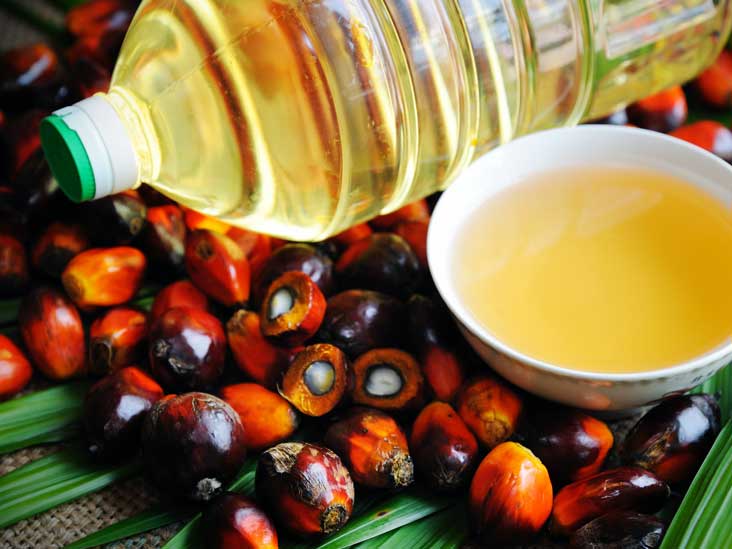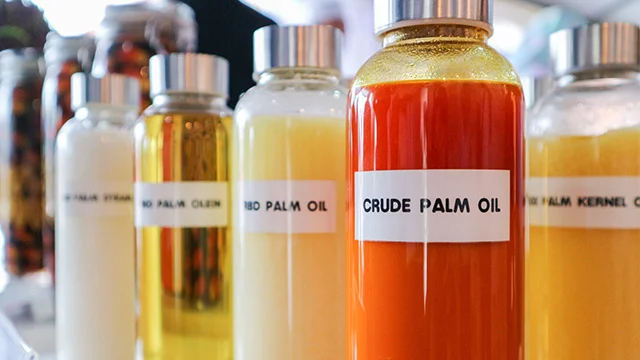One of the most popular vegetable oils in the world, palm oil is used in everything from baking products and cooking oils to biofuels and cosmetics. But not all palm oils are made equal. Crude palm oil (CPO) and refined palm oil (RPO), the two primary types of palm oil, have different properties, processing techniques, and applications. Understanding the differences between them is crucial for manufacturers, suppliers, and consumers alike.
What Is Palm Oil?
The mesocarp, or fleshy portion, of the oil palm fruit (Elaeis guineensis) is where palm oil is extracted. It’s a high-yield, versatile oil, with a balanced fatty acid composition and a natural reddish color due to its high beta-carotene content. The special quality of palm oil is that it stays semi-solid at room temperature, which makes it perfect for industrial and food processing uses.
Palm fruit is used to make two primary types of oil:
- Crude palm oil, or CPO, is taken straight out of the pressed fruit.
- Refined palm oil (RPO) undergoes additional processing to enhance stability and eliminate contaminants.

Crude Palm Oil (CPO): An Overview
Definition:
Crude palm oil is the unrefined oil obtained after sterilizing, stripping, digesting, and pressing the oil palm fruit.
Color and Appearance:
CPO is reddish-orange in color and semi-solid at room temperature due to its high content of carotenoids, especially beta-carotene.
Composition:
- High in free fatty acids (FFA).
- Contains phospholipids, peroxides, and trace metals.
- Rich in tocopherols and tocotrienols, which are carotenoids and vitamin E.
Uses:
- Utilized frequently in the food sector in areas with little capacity for refining.
- Used in soap production and as a base for refining into higher-quality oils.
- Increasingly used in biofuel and animal feed.
Storage Concerns:
CPO is prone to oxidation and rancidity if not stored properly due to its impurities and FFA content. This affects shelf life and safety.
If you are interested in the production process of crude palm oil, you can read this article: What Are the Machines Used for Palm Oil Processing?

Refined Palm Oil (RPO): An Overview
Definition:
CPO that has undergone refining to eliminate contaminants, color, flavor, and free fatty acids is known as refined palm oil.
Color and Appearance:
RPO is typically pale yellow or white, has a neutral odor, and a cleaner taste. It’s fully or partially hydrogenated in some products.
Refining Process Involves:
- Degumming: Removal of phospholipids.
- Neutralization: Removal of FFA using alkali.
- Bleaching: Decolorization by removing pigments like carotenoids.
- Deodorization: Removal of volatile compounds and odors via steam distillation.
Composition:
- Much lower in FFA.
- Reduced carotenoids and vitamin E content.
- Stable shelf life and more resistant to oxidation.
Uses:
- Common in the food industry—in margarine, instant noodles, snacks, baked goods, and deep-frying oils.
- Used in cosmetics, pharmaceuticals, and household products.
- Suitable for long-distance trade and export.
Key Differences Between Crude and Refined Palm Oil
| Feature | Crude Palm Oil (CPO) | Refined Palm Oil (RPO) |
| Color | Deep reddish-orange | Pale yellow to white |
| Odor | Strong, pungent | Neutral or odorless |
| Taste | Distinct, earthy | Neutral |
| FFA Content | High | Low |
| Nutrient Content | High carotenoids, tocopherols | Reduced due to refining |
| Stability | Less stable, prone to rancidity | More stable, longer shelf life |
| Applications | Soap, animal feed, biofuel, and limited food use | Food, cosmetics, pharmaceuticals, and exports |
| Storage Requirement | Sensitive to light and heat | Easier to store and ship |
| Regulatory Approval | May not meet food-grade standards | Meets international food safety standards |
Health and Nutritional Considerations
Crude Palm Oil:
- Pros: Rich in natural antioxidants (vitamin E and carotenoids).
- Cons: High FFA content may affect digestibility and safety; it is not suitable for direct consumption in many regions.
Refined Palm Oil:
- Pros: Free from impurities, safe for consumption, neutral taste.
- Cons: Nutrient loss during refining, especially antioxidants and carotenoids.
Trans Fats:
Refined palm oil may be partially hydrogenated in processed foods, increasing trans fat content, which is a health concern. However, palm oil is naturally trans fat-free if not hydrogenated.
Industrial and Economic Significance
Crude Palm Oil:
- Cheaper to produce, hence used widely in developing economies.
- Exported for refining in importing countries with better infrastructure.
Refined Palm Oil:
- Preferred in developed markets due to food safety standards.
- Supports value-added industries like cosmetics, processed food, and pharmaceuticals.
Export Dynamics:
Major producers like Indonesia and Malaysia export both CPO and RPO. However, there’s a global shift towards refining domestically before exporting to maximize profits and job creation.
Sustainability and Environmental Impact
Both types of palm oil are subject to scrutiny over deforestation, land use, and carbon emissions. However, refining adds another layer of:
- Energy consumption
- Water use
- Effluent discharge
To address this:
- Sustainable practices are guaranteed by RSPO (Roundtable on Sustainable Palm Oil) certification.
- Manufacturers are moving toward zero-waste refining and biomass energy for processing.
Market Trends and Consumer Preferences
Health-Conscious Markets:
Refined palm oil is favored for being cleaner and meeting food safety regulations in markets like the EU, the US, and Japan.
Natural Product Segments:
There’s growing interest in minimally processed oils, including CPO, due to their natural antioxidant content, especially in organic and artisanal sectors.
Price Sensitivity:
CPO is generally cheaper, but RPO fetches higher prices due to its wider application, longer shelf life, and compliance with international quality standards.
Regulations and Food Safety
Crude Palm Oil:
- May contain GE (glycidyl esters) and 3-MCPD, which are potential carcinogens if not removed.
- Not approved for direct consumption in many countries.
Refined Palm Oil:
- Meets Codex Alimentarius and FDA requirements for edible oils.
- Lower in harmful substances due to deodorization and neutralization.
Labeling Requirements
- RPO is often listed as “vegetable oil” or “palm oil” on food labels.
- CPO is rarely listed in consumer-facing products.
Choosing the Right Type for Your Needs
Use CPO if:
- You’re in soap, biodiesel, or animal feed manufacturing.
- You want to retain high antioxidant content for niche markets.
- You have refining capabilities on-site or nearby.
Use RPO if:
- You need an odorless, long-lasting, and safe oil for consumer goods.
- Your products are intended for international export.
- You prioritize regulatory compliance and product stability.
If you are considering which business to start between these two products, you can also read this article, which I hope will help you make your choice: Crude Palm Oil Mill vs. Refinery Operations Explained


